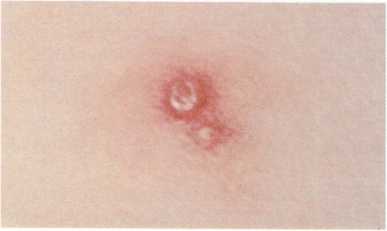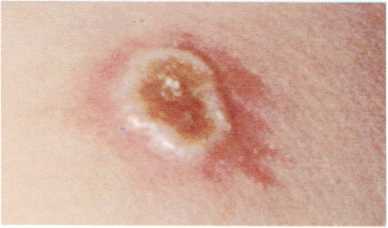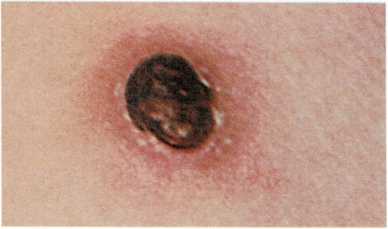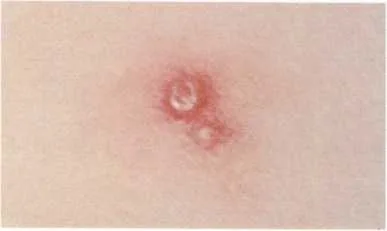Smallpox – Sore Throat
Smallpox was one of the most feared of contagious diseases.
Throughout history, it brought death, blindness, or disfiguring facial
scars to hundreds of millions of people. But it became the first disease
to be conquered by medical science. The last known case of smallpox in
the United States occurred in 1949, and the last known naturally
occurring case in the world was in Africa in 1977. In 1980, the World
Health Organization announced that smallpox had been wiped out.
Smallpox was spread by a virus through direct contact with the coughing
or sneezing of a patient, or the pus from a patient’s sores, or from
articles the patient had used. The disease began with chills, fever,
vomiting, headaches, and backaches. Red spots appeared on the patient’s
skin about three or four days after the onset of the disease. Later,
these spots changed to blisters filled with pus.
As the patient recovered, the blisters dried up and formed scabs that
fell off, leav-

About three days after a smallpox vaccination, a small, red, itchy
pimple appears.

About nine days after vaccination, the pimple develops a white-colored
blister.

About 14 days after vaccination, the blister dries up and forms a
scab.

About 21 days after vaccination, the scab falls off and leaves a
scar.
ing scars. About 20 per cent of all those contracting smallpox died.
Survivors were permanently scarred, and many were blinded.
The war against this dreadful disease began in the year 1796, when an
English doctor, Edward Jenner, developed a vaccine that prevented
smallpox. (It was also the first vaccine to be developed.) Use of the
vaccine soon spread to other nations.
While the disease was still widespread, the federal and local
governments in the United States instituted regulations making smallpox
vaccinations routine for all persons. Usually, vaccinations were given
to children between 1 and 2. Vaccinations were also required for anyone
traveling to and from countries where smallpox was known to occur
regularly. In 1971, the program of routine vaccinations for children was
terminated, and smallpox vaccinations are no longer required for foreign
travel.
Smothering. See Suffocation
Sneezing. Most babies sneeze occasionally, even when they do not
have a cold. Sneezing is how a baby cleans dirt, lint, or mucus from the
nose. Tiny hairs that line the nose move the mucus and other material
down the nose. This material usually collects in a ball on the large
hairs near the opening at the front of the nose. This collection tickles
and makes the baby sneeze the material out.
Usually, you can tell when your baby is getting a cold because there
will be more than the normal drop or two of mucus in the sneeze. Also, a
baby with a cold is more apt to be irritable, may have trouble eating
because of nasal congestion, may lose normal appetite, and may show
other signs of illness such as fever.
Lint frequently irritates a baby’s nose and causes sneezing. You can
eliminate some of the lint in new blankets and baby clothes if you wash
them before using. [m.g.]
See also Colds
Soft spots (fontanels) are areas of a baby’s skull where the bones
have not yet
joined and hardened. In place of bone, a very tough membrane covers the
area.
A baby may have as many as six soft spots at birth. Generally, you can
feel only two of them. Gradually, through the months, the soft spots
disappear as the skull bones grow and harden. By the time a baby is a
year old, it is usually hard to find the soft spots.
The largest soft spot is shaped like a diamond and is about 1 to IW
inches (2.5 to 4 centimeters) on a side. It is just in front of the top
of the child’s skull. Another large spot is at the back of the skull.
The fontanels vary in size in different babies.
Although the brain may seem unprotected in these softer areas, the tough
membrane is actually very strong. Mild shampoos and ordinary handling of
the head and scalp will do no harm. In fact, shampooing the baby’s
scalp, including the soft spots, is necessary to prevent cradle cap, a
scalp condition that causes whitish scales, [m.c.]
See also Cradle cap
Sore throat usually results from an infection. It may range from a
mild soreness to a painful condition in which the child has difficulty
in swallowing.
Children often have sore throats. The infection can accompany colds,
tonsillitis, and other illnesses. Call your doctor if your child has a
fever along with the sore throat, if the throat is more than mildly
sore, or if the sore throat persists.
Because most sore throats are caused by viruses, they cannot be cured
with antibiotics. Your doctor will probably prescribe acetaminophen
(aspirin substitute) or other drugs to control fever. Doctors generally
do not recommend gargling for children, but throat lozenges for children
may help relieve minor irritations. The doctor may take a culture from
the child’s throat to check for streptococcic infection (strep throat).
If your child does have strep throat, your doctor will prescribe
antibiotics, [m.g.]
See also Colds; Communicable diseases;
Strep throat; Tonsillitis; Virus
Spine, curvature of. See Scoliosis

